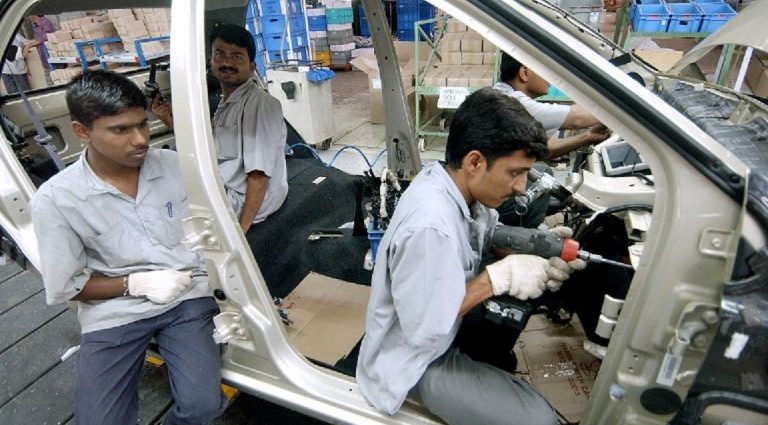
India, by some estimates, is the world’s most populous country and one of its most youthful. But as its population and economy expand – the International Monetary Fund projects the economy to grow by 6.1% this year, among the fastest in the world – so is the unemployment rate.
Unemployment stood at 7.45% in February, up from 7.14% in January. And estimates show the rate increasing to 7.80% in March, including 8.51% in urban areas.
Creating stable jobs for Indian youth is a top challenge for the government of Prime Minister Narendra Modi. Nine out of 10 workers are in the informal economy. According to the World Bank, the participation rate of women in the workforce in 2021 was 23%.
Not only is this low compared with global standards but it has declined even as India has become richer. To be sure, the government has tried to formalize the economy and increase female participation.
New Delhi now finds itself in a precarious position, as the rising unemployment rate threatens to upend a surging economy. To harness India’s economic potential, several challenges – both geopolitical and domestic – lie ahead.
The first is structural. Unlike the Asian Tiger economies that were largely based on export-oriented manufacturing, India’s is dominated by services. Services exports, of which information technology is the largest component, also generate an export surplus, which helps cushion India’s current-account deficit.
These industries mostly sustain white-collar jobs unable to absorb most of India’s youth. Manufacturing, which is meant to create more jobs, was 14% of GDP in 2021, after services (47.5%) and agriculture (16.8%).
The Modi government has introduced “production-linked incentives,” which aim to offer about US$25 billion worth of subsidies to incentivize manufacturing in 14 sectors, including semiconductors. This is no doubt also motivated by geopolitics, as India is trying to corner some gains created by Western democracies decoupling supply chains from China.
Consensus elusive
Which creates the second challenge for the government. Unlike the Asian Tigers, which were autocratic regimes, India is still a democracy, albeit flawed. As the government’s unsuccessful efforts at deregulating agricultural markets in 2021 showed, it will be difficult to pursue economic reforms without first achieving widespread political consensus.
Unfortunately, institutions meant to produce such a consensus in India, such as regulatory and oversight bodies, Parliament, and the media, now increasingly toe the government line.
Although vigorously rejected by the government, global democracy watchdogs have recently downgraded India on their indices.
Linked to this is the third challenge, which is how India invites consistently high levels of foreign investment. Recent allegations of financial fraud against the Adani Group also cast aspersions on the regulatory ecosystem.
These allegations, currently under investigation by an independent panel in India, do not enhance investor confidence. How will India then attract the foreign capital it badly needs to finance its manufacturing boom?
The fourth challenge is the nature of government-business relations, which has enabled the concentration of economic power in a few conglomerates. Unlike the Asian Tigers, the government’s favored domestic champions are focused on the local market rather than exports. This may not lead to a manufacturing-jobs boom.
The 2023 federal budget sent contradictory signals to Indian startups: The budget extended the tax holiday period for startups, yet brought foreign capital under the ambit of a tax on capital raised by startups, derisively referred to in the media as an “angel tax,” further restricting access to foreign capital.
Fifth, job growth needs a stable social fabric. Under Modi’s Hindu-nationalist government in power since 2014, there have been rising incidents of violence and hate speech, most of it directed against religious minorities.
Last year, India’s Supreme Court had to direct three state governments to order police to take action against hate speech. A former governor of India’s central bank warned in 2017 that the pursuit of populist nationalism would damage economic growth.
Possibly sensing this as India hosts the Group of Twenty this year, Modi instructed members of his Bharatiya Janata Party (BJP) in January to reach out to religious minorities.
A low and declining female labor force participation rate may have befuddled economists, yet sociologists have long pointed to conservative patriarchal attitudes as a contributing factor. As its stand on same-sex marriage in an ongoing Supreme Court case showed, the government defers to its conservative base on important social questions.
Emerging middle power
Last, India is a hedge power in the current geopolitical competition between the US and its allies on one side and China and Russia on the other.
Since 2020, India has restricted Chinese investment after deadly military clashes at their disputed border. It remains to be seen how much the US, the European Union and Japan can marshal their private sectors to invest in India. This explains why India has chosen to pursue strategic relations with several countries in the Persian Gulf region, over and above crude oil and labor.
Yet these investment plans have sometimes run into rough weather due to India’s domestic politics. Resolving these challenges while maintaining the ruling BJP’s popularity with voters will be a complicated knot for the government to untie.
The government has rolled out a large welfare delivery system linked to digital platforms and a nationwide biometric ID program. Yet long-term income redistribution will merely keep people afloat. Only well-paying, stable jobs can lead to enhanced social stability, entrepreneurship, and innovation.
India will need to unlock its economic potential if it wants to maintain its strategic independence as a hedge-power amid ongoing geopolitical turbulence.
Creating jobs for its people is a key piece of this puzzle.
This article was provided by Syndication Bureau, which holds copyright.

